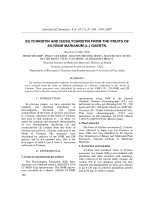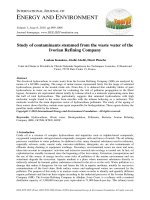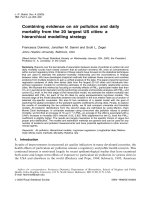Carlson wade health from the hive honey bee P(BookZZ org)
Bạn đang xem bản rút gọn của tài liệu. Xem và tải ngay bản đầy đủ của tài liệu tại đây (516.1 KB, 166 trang )
title:
author:
publisher:
isbn10 | asin:
print isbn13:
ebook isbn13:
language:
subject
publication date:
lcc:
ddc:
subject:
Health From the Hive : Honey, Bee Pollen, Bee
Propolis, Royal Jelly
Wade, Carlson.
NTC Contemporary
0879835818
9780879835811
9780071393348
English
Bee products--Health aspects.
1992
RA784.W237 1992eb
615/.321
Bee products--Health aspects.
Page i
Health from the Hive
Page ii
Keats Books by Carlson Wade
The Amino Acids Book
Arthritis, Nutrition and Natural Therapy
Bee Pollen and Your Health
Fats, Oils, and Cholesterol
Hypertension and Your Diet
The Lecithin Book
Nutrition and Your Immune System
The PMS Book
Pocket Handbook of Juice Power
Propolis: Nature's Energizer
Vitamins, Minerals and Other Supplements
Page iii
Health from the Hive
Honey . . . Bee Pollen . . . Bee Propolis . . . Royal Jelly
Carlson Wade
KEATS PUBLISHING, INC.,
New Canaan, Connecticut
Page iv
HEALTH FROM THE HIVE is not intended as medical advice. Its intent is solely
informational and educational. Please consult a health professional should the need for
one be indicated.
HEALTH FROM THE HIVE
Copyright © 1992 by Carlson Wade
All Rights Reserved
No part of this book may be reproduced in any form without the written consent of the
publisher.
Library of Congress Cataloging-in-Publication Data
Wade, Carlson.
Health from the hive / by Carlson Wade.
p. cm.
Includes bibliographical references and index.
ISBN 0-87983-581-8 : $9.95
1. Bee productsHealth aspects. I. Title.
RA784.W237 1992
615'.321dc20
92-21655
CIP
Printed in the United States of America
Published by Keats Publishing, Inc.
27 Pine Street (Box 876)
New Canaan, Connecticut 06840-0876
543
Page v
To the honeybee . . .
Sacred source of life
Page vii
CONTENTS
Introduction
ix
Part I
Honey
1
The Worship of HoneyHealing Foods from the Beehive
Honey in the Bible
Honey in Ancient Egypt
Honey in Greece
Honey in Rome
What Is Honey
The Bee Colony
Honeybee Facts at a Glance
How Honey Is Produced
Honey, It's a Natural
Caring for Honey
Honey Color and Flavor
How to Use Honey
Honey Nutrition Facts
Honey Is a Source of Youthful Energy
Honey Heals Wounds
Using Honey as a Natural Medicine
Long Live the Bee
About Bee Stings
Honey Trivia
Part II
Bee Pollen
Food of the Godsfor Mortals
31
What Is This Power Food?
Pollen: What's in It for You?
Looking Into the Power-Packed Pollen Pellet
Vitamins in Pollen
Protein in Meat vs. Pollen
The Power of Pollen for Healing
Bee Pollen + Honey = Better Health
Healing With Pollen
The President's Health Food
Amazing Wonder Food
Helps Boost the Immune System
AsthmaBreathe Free and Easy
Athletes and Bee Pollen
Easy Ways to Use Pollen
How Perfect Is Pollen?
Common
Page viii
and Uncommon Healing Remedies
Your Pollen Program
Look Younger With Bee Pollen
Is Bee Pollen a Miracle Food?
How to Heal Your Allergies with Bee Pollen
How Pollen Rebuilds Your Immune System
How Bee Pollen Helps You Live Longer
Part III
Propolis
93
PropolisMiracle Healer from the Beehive
Protects Against Bacterial Infections
Getting Acquainted with Bee Propolis
Healer Used by the Ancients
Propolis: What's in It for You?
The Bioflavonoid Connection
Healings Reported with Propolis
The Doctors Praise Healing Power of Propolis
Folk Remedies
Propolis Preparations
Part IV
Royal Jelly
125
Royal Jelly: Fountain of Youth
Doctors Who Recommend Royal Jelly
The Miracle of Royal Jelly and the Queen Bee
A Closer Look at Royal Jelly
Royal JellyWhat's in It for You?
Conclusion
The Amazing World of Bees and Their Foods
155
About Honey
About Pollen
About Royal Jelly
References
161
Page ix
INTRODUCTION
The beehivea fountain of youth and health!
Since the birth of the world, the honeybee has existed to create life for almost all other
living creatures. Through the means of pollination, the honeybee has been able to
nourish itself and all the inhabitants of the hiveunlike any other creature known. Life, as
we know it, might not exist were it not for the miraculous honeybee, worshipped for its
sacred abilities to fertilize plants and vegetation on our planet.
The honeybee is involved in preparing a set of foods that modern science recognizes as
possessing amazing healing properties. Honey, pollen, propolis, and royal jelly are foods
that are amazingly rich in a treasure of nutrients that doctors throughout the world have
hailed as "natural medicines."
This book enters the beehive, joins with the swarms of buzzing bees to discover an
astonishing civilizationright in the hive!
You will read the latest scientific reports on how these foods from the beehive can
revitalize the body, reverse illness and roll back the aging clock; and you will learn the
simple ways in which you can use these foods yourself to regenerate both body and mind.
In modern times, you need to protect your immune system. You are being assaulted by
heavy metals in the air you breathe, with antibiotics and hormones in your meats,
Page x
pesticides in your fruits and vegetables, herbicides in your grains and endless additives
and preservatives in your foods.
Medical studies caution that we are facing an onslaught of never-before-seen organisms
which threaten us daily.
How can you strengthen your immune system against these threats? Take a lesson from
the honeybee. It has made itself and its residence, the hive, a fortress against
environmental attack. That is how it has survived for over 45 million years!
The secret? A set of foods made in the hive. In this book I propose to show you how you
can partake of these foods and boost your immune system to protect yourself against
these toxic dangers of our chemical age.
CARLSON WADE
Page 1
PART ONE
HONEY
Page 3
The Worship of HoneyHealing Food from the Beehive
Since ancient times, honey has been considered of almost divine creation. Throughout
antiquity right into our space age, honey and other foods from the beehive remain far and
above anything else as having miracle healing powers.
At what stage in man's evolution was it recognized that honey has beneficial properties?
We cannot know. Most likely, it was instinctive. Many lower animals go to great
Page 4
distances to find the bee for its honey. While we know very little about the diet of early
man, we do have evidence of honey forming a valuable part of the eating plan. Honey
has always been more than a tasty, healing food. It has been a source of worship for its
therapeutic powers.
Honey in the Bible
We can discover much about the early use of honey from Biblical references. The use of
honey as an internal and external remedial food must be much older than the history of
medicine itself; it is, beyond doubt, the oldest panacea. In the most ancient scripts, we
find references to honey as a glorified food, an ingredient of favored drinks, a popular
natural medicine, and the principal component of liniments and plasters. The oldest
mythologies praised the invigorating and health-giving qualities of honey. Many allusions
were made to its magic healing powers. Honey is frequently mentioned and adored in the
Bible.
My son, eat thou honey, because it is good; and the honeycomb, which is sweet to thy taste. Proverbs 24:13
And I am come down to deliver them out of the hand of the Egyptians, and to bring them up out of that land unto
a good land and a large, unto a land flowing with milk and honey. Exodus 3:8
But Jonathan heard not when his father charged the people with the oath; wherefore he put forth the end of the
Page 5
rod that was in his hand, and dipped it in a honeycomb, and put his hand to his mouth; and his eyes were
enlightened. Then said Jonathan, My father hath troubled the land; see, I pray you, how mine eyes have been
enlightened, because I tasted a little of this honey. I Samuel 14:27-29
Thou didst eat fine flour, and honey, and oil; and thou wast exceeding beautiful, and thou didst prosper into a
kingdom. Ezekiel 16:13
''Hast thou found honey? Eat so much as is sufficient for thee." Proverbs 25:16
He made him ride on the high places of the earth, that he might eat the increase of the field; and he made him to
suck honey out of the rock. Deuteronomy 32:13
He should have fed them also with the finest of the wheat; and with honey out of the rock should I have satisfied
thee. [In the countryside bees would frequently build nests in the side of cliffs and rocks.] Psalm 81:16
And after a time he returned to take her, and he turned aside to see the carcass of the lion; and behold, there was
a swarm of bees and honey in the carcass of the lion. And he took thereof in his hands, and went on eating, and
came to his father and mother, and he gave them, and they did eat; but he told them not that he had taken the
honey out of the carcass of the lion. Judges 14: 8-9.
We came unto the land whither thou sentest us, and surely it floweth with milk and honey; and this is the fruit of it.
Numbers 13:27
Page 6
More to be desired are they (the judgment of the Lord) than gold, yea, than much fine gold: sweeter also than
honey and the honeycomb. Psalm 19:10
What is sweeter than honey? and what is stronger than a lion? Judges 14:18
So we see that honey was prized as a source of sustenance, so much that the Israelites
would never make sacrifices using honey, which they considered to be of special value
and healing.
Honey in Ancient Egypt
During the 40th century B.C., honey was used in most households as a sweetener. The
Egyptians valued honey highly; it was commonly used as a tribute or payment. It was
also used to feed sacred animals.
In the Fifth Dynasty temple of Niweserre at Abusir, built around 2500 B.C., there are
scenes depicting early beekeeping. The hives appear as cylindrical pipes piled up in
horizontal rows. Each hollow tube, made of sun-baked mud, appears to be about four feet
in length and about eight inches in diameter. The pipes are situated together in a manner
to be protected from the sun's heat by a mud coating; in some cases, shade is provided
by tree branches. In many parts of the Middle East, similar hives can still be seen.
Honey was used as part of the Egyptian diet. In the tomb of Rekhara of the Eighteenth
Dynasty, built around
Page 7
1500 B.C., there are drawings showing men baking cakes with honey. From surviving
records, Rameses III presented a foreign king with a gift of 7050 jars of honey.
Egyptians chiseled a likeness of the honeybee on many monuments, painted scenes of
beekeepers tending bees on the walls of their tombs and even recorded activities of this
hard-working creature in holy hieroglyphics inscribed on papyrus scrolls. Writings over
2000 years old reveal that Egyptian physicians called honey the "universal healer." During
this time, Egyptians paid three drachmas per quart for strained honey.
Next to hieroglyphic representations, the wall paintings of the royal tombs demonstrate
the great national importance of honey. In most tombs, bees and honey are represented
pictorially. Honeycombs, honey cakes, sealed jars of honey and lotus blossoms were
placed next to the sarcophagi as food for the souls of the dead.
In the tomb of Pa-Ba-Sa, in Thebes, the entire wall is decorated by rows of bees. A man
is shown pouring honey into a pail, another is kneeling and praying before a pyramid of
honeycombs. On the wall of the tomb of Rekh-Mi-Re all phases of the honey industry are
depicted: how the combs were removed from the hives with the aid of smoke, the baking
of honey cakes, the filling and sealing of jars, etc.
The Egyptian papyri, representing the oldest civilization in the world, often refer to
honey, especially to its medicinal value. Almost all Egyptian medicines contained honey,
wine and milk. Honey sacrifices were offered to the deities. The frequent symbolic use of
bees in Egypt must be attributed not only to the fact that honey was an important article
of
Page 8
commerce and a valuable food and medicinal substance but to the admiration of the
Egyptians for the diligence, industry, order, economy, endurance, intelligence and
courage of the bees and their loyalty to a sovereign. The bees are the only creatures
which are entirely subjugated to a ruler. Next to the signatures of Egyptian kings could be
seen the figure of a bee.
The ancient Egyptians were habitual beer drinkers. The land was ill-suited to the
cultivation of the grape vine. Xenophon (400 B.C.) mentions an Egyptian beverage made
of wheat, barley and honey.
Honey in Greece
Honey appears in much of Greek mythology. For example, the Greeks credit Aristaeus,
son of Apollo and Cyrene, with bringing the knowledge of bees and honey to mortal man.
That is, Aristaeus was educated by the Muses, the nine Greek goddesses who were
patrons of the arts. This relationship led to bees being called the "birds of the Muses." It
was also believed that if a bee touched a child's lips, he would develop magical qualities
to perform the various arts. Legend says that bees kissed such philosophers as Sophocles
and Plato.
Ambrosia, the food, and nectar, the drink of the gods, were made of honey. The honey of
Mt. Hymettus was a daily food of Athens. The mountain was covered with fragrant wild
flowers, basically thyme; the air was scented with the delightful fragrance of the blooms.
Bees were partial to
Page 9
these hills. Ancient Attica, with its area of forty square miles, recorded twenty thousand
hives during the time of Pericles (429 B.C.). All ancient Greek authors praised the
medicinal and nutritional value of Attica honey, "the crowning dish of all feasts." The
oldest ruins in the rural districts of Greece are buildings which originally housed the hives.
These stone edifices were built high, to outwit the cunning of the bears, arch-enemies of
bees and connoisseurs of honey. An ancient custom was the offering of honey to the gods
and to spirits of the dead. Mead, an alcoholic drink made with honey, was considered the
drink of the Greek gods.
Honey in Rome
In Roman times, honey served as a food preservative as well as being part of the regular
fare. According to Coelius Apicius, author of The Roman Cookery Book, each villa had a
separate enclosure reserved for beehives, tended by a servant. This enclosure known as
a mellarius, would provide a daily supply of honey. The Roman author Virgil (7019 B.C.)
in his Georgics or Art of Husbandry devotes a big section to the art of beekeeping. Virgil
tells how honey is harvested and used and tells how it may improve the quality of poor
wine thus:
You'll strain sweet honey, sweet and clear enough
To tame the bitter flavor of the wine.
Virgil also says, "Next I sing of honey, the heavenly
Page 10
ethereal gift." He then praises honey in the Aeneid as "the sweet-scented honey, fragrant
with thyme."
Pliny the Elder, who lived in Rome between 23 and 79 A.D. and wrote the great Natural
History, believed that the daily use of honey would insure a long and healthy life. He tells
how foods and drinks, mixed with honey, were seen in the daily menus of Rome. It was a
courteous act of the Romans to offer a respected guest some honey, fresh from the hives.
The host welcomed his visitors with the greeting, "Here is honey which the gods provided
for your health."
Pliny also tells of other lands, including the British Isles, in which honey was considered a
rich treasure of health.
So we see that since the dawn of time honey has been prized. It was enjoyed throughout
Europe, and conquering Spaniards found that the natives of 16th-century Mexico and
Central America had also developed beekeeping. A distinct family of honeybees were
native to the Americas.
European settlers introduced European honeybees to New England in about 1638. The
North American natives called these honeybees the "white man's flies."
What Is Honey?
It is a sweet, viscous fluid produced by bees from plant nectar. It is a golden sweet elixir
concocted by the honey-
Page 11
bees. No one has been able to devise a way to manufacture this delicious golden liquid. It
is the result of the cooperative efforts of every bee that lives and works in the murmurous
hive, abuzz with constant activity.
The Bee Colony
The bee colony is a thriving home for as many as 50,000 members, sometimes even
more.
The modern hive is a series of boxes, stacked atop one another, as opposed to a hollow
tree. Inside these boxes hang frames in which the bees build their combs; the bottom set
of boxes is the actual working and living area for the colony of bees. All the boxes
stacked above are called "supers" and are placed there by the beekeeper for the bees to
fill with honey.
Three types of bees live in the colony:
Queen: This bee lives for two or three years and exists primarily to produce eggs. She
mates only once and is capable of laying 1500 eggs every day until her death. When
necessary (usually at the beginning of Spring) the queen bee lays unfertilized eggs which
produce drones.
Drones: These bees have only one purpose in life, to mate with a new queen. They do
not work in the hive, and do not gather pollen or nectar. When food supplies get low or
the other bees are too busy to care for them, they are pushed out of the hive to die.
Workers: These bees are the most interesting. Not more than one day after the worker
emerges from her brood cell,
Page 12
she begins her life of unending toil. The worker has these duties:
1. To clean the brood cells in preparation for the queen's egg-laying process and feed the
larvae from the royal jelly she secretes. (It takes over 3000 workers over 10 hours of
nursing and feeding for a single larva to emerge as a healthy contributor to hive life.)
When the worker bee is about two weeks old, her nursing duties end and she becomes a
"house bee."
2. As "house bee," she is responsible for the inside of the hives; she produces wax and
repairs combs, helps unload nectar, pollen, water and propolis (a sticky substance used in
hive building) which are then delivered by older bees to the hive. She is then responsible
for storing food and distributing it to the brood, cleaning the hive of dead bees, and
protecting the hive from invaders. If it gets too hot, she fans the hive; if it gets really hot,
she flies out, gets water (in her honey stomach) and bathes the entire hive. After her
days of tending house are completed, she becomes a field bee. Her life lasts only five
weeks.
Honeybee Facts at a Glance
The Colony: Honeybees are social insects, with a marked division of labor between the
various types of bees in the
Page 13
hive. A hive of honeybees includes a queen, drones and workers.
The Queen: The only sexually developed female in the hive, she is larger than either the
drone or the worker bee. If a two-day-old larva is selected by the workers to be reared as
a queen, she will emerge from her cell eleven days later to mate in flight with
approximately 18 drone (male) bees. During this mating, she receives several million
sperm cells, which last her entire lifespan of nearly two years. The queen starts to lay
eggs about two days after mating. A very productive queen can lay 3,000 eggs in a single
day.
The Drones: Drones are much stouter than queens or workers. The drone is a male and
has no stinger. He does not collect food or pollen from flowers, nor does he secrete wax.
His sole purpose is to mate with the queen. If the colony is short on food, drones are
often kicked out of the hive.
The Workers: Workers, the smallest bees in the colony, are sexually undeveloped
females. A colony can have 50,000 to 60,000 workers. The lifespan of a worker bee varies
according to the time of the year. It is approximately 28 to 35 days. Workers that are
reared in September and October, however, can live throughout the winter. Workers feed
the queen and larvae, collect nectar, guard the hive entrance and help keep the hive cool
by fanning their wings.
In addition, honeybees produce the wax comb. The comb is composed of hexagonal cells
which have walls that are only 2/1000 of an inch thick, but support 25 times their own
weight.
The honeybee's wings stroke 11,400 times per minute, thus making their distinctive buzz.
Page 14
How Honey Is Produced
The bee gathers the nectar from the flower; the liquid passes into its honey sac and is
mixed with acid secretions at the base of its tongue. The bee then flies back to the hive
where the honey is deposited. A brewing process takes place at a temperature of 80 to
85° F. (In the very heart of the hive, it may be 97° F.) The bee is not a natural honey
maker; the younger ones are taught by the more experienced ones.
Bees will fly two to three miles to find flowers with the right nectar. A bee might travel as
much as 40,000 miles to produce honey to fill a single one-pound jar.
After the honey has been produced by the bee, the beekeeper uncaps the combs, placing
them in a centrifugal force machine (extraction) to remove the honey. It is then delivered
to the plant where it is simply strained and heated in order to liquefy it so it can be
poured into the jar.
The average yield of honey per hive is 45 pounds. Approximately 200 million pounds of
honey are produced yearly in the United States and an equivalent amount in the rest of
the world.
Honey, It's a Natural
Honey adds beautiful golden color and delightful sweet flavor to bring out the best in so
many foods. It is available in a variety of forms.









